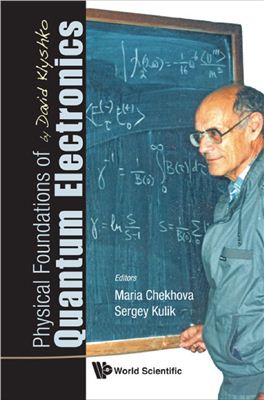World Scientific Publishing, 2011, 347 pages
This concise textbook introduces a graduate student to the various fields of physics related to the interaction between radiation and matter. The scope of the book is very broad, ranging from nonlinear to quantum optics and from quantum transitions in atoms to the dispersion of polaritons in continuous media.
Most parts of the book contain the lecture courses taught by David Klyshko at Moscow State University, namely, quantum electronics, nonlinear optics and quantum optics. In every section, the main focus is on observable effects and their physical interpretation. The book emphasizes analogies and relations between seemingly different phenomena and different fields of quantum electronics.
The main focus is on the three directions in physical optics that appeared after the advent of lasers: nonstationary interactions between light and matter (Chapter 5), optical anharmonicity of matter (Chapter 6) and quantum properties of light (Chapter 7). The first four chapters describe the theoretical base of more traditional parts of quantum electronics. The book starts with a short review of the history of quantum electronics with its main concepts, ideas, and terms. Further, basic methods for describing the interaction of optical radiation with matter are considered, based on quantum transition probabilities (Chapter 2), the density matrix formalism (Chapter 3), and the linear dielectric susceptibility of matter (Chapter 4).
This concise textbook introduces a graduate student to the various fields of physics related to the interaction between radiation and matter. The scope of the book is very broad, ranging from nonlinear to quantum optics and from quantum transitions in atoms to the dispersion of polaritons in continuous media.
Most parts of the book contain the lecture courses taught by David Klyshko at Moscow State University, namely, quantum electronics, nonlinear optics and quantum optics. In every section, the main focus is on observable effects and their physical interpretation. The book emphasizes analogies and relations between seemingly different phenomena and different fields of quantum electronics.
The main focus is on the three directions in physical optics that appeared after the advent of lasers: nonstationary interactions between light and matter (Chapter 5), optical anharmonicity of matter (Chapter 6) and quantum properties of light (Chapter 7). The first four chapters describe the theoretical base of more traditional parts of quantum electronics. The book starts with a short review of the history of quantum electronics with its main concepts, ideas, and terms. Further, basic methods for describing the interaction of optical radiation with matter are considered, based on quantum transition probabilities (Chapter 2), the density matrix formalism (Chapter 3), and the linear dielectric susceptibility of matter (Chapter 4).

